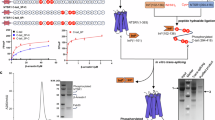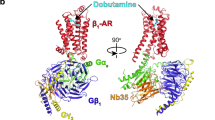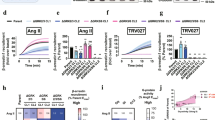Abstract
β-Arrestins are a small family of proteins important for signal transduction at G protein-coupled receptors (GPCRs). β-Arrestins are involved in the desensitization of GPCRs. Recently, biased ligands possessing different efficacies in activating the G protein- versus the β-arrestin-dependent signals downstream of a single GPCR have emerged, which can be used to selectively modulate GPCR signal transduction in such a way that desirable signals are enhanced to produce therapeutic effects while undesirable signals of the same GPCR are suppressed to avoid side effects. In the present study, we evaluated agonist bias for compounds developed along a drug discovery project of β2-adrenoceptor agonists. About 150 compounds, including derivatives of fenoterol, 2-amino-1-phenylethanol and 2-amino-2-phenylethanol, were obtained or synthesized, and initially screened for their β-adrenoceptor-mediated activities in the guinea pig tracheal smooth muscle relaxation assay or the cardiomyocyte contractility assay. Nineteen bioactive compounds were further assessed using both the HTRF cAMP assay and the PathHunter β-arrestin assay. Their concentration-response data in stimulating cAMP synthesis and β-arrestin recruitment were applied to the Black–Leff operational model for ligand bias quantitation. As a result, three compounds (L-2, L-4, and L-12) with the core structure of 5-(1-amino-2-hydroxyethyl)-8-hydroxyquinolin-2(1H)-one were identified as a new series of β-arrestin-biased β2-adrenoceptor agonists, whereas salmeterol was found to be Gs-biased. These findings would facilitate the development of novel drugs for the treatment of both heart failure and asthma.
Similar content being viewed by others
Log in or create a free account to read this content
Gain free access to this article, as well as selected content from this journal and more on nature.com
or
References
Overington JP, Al-Lazikani B, Hopkins AL. How many drug targets are there? Nat Rev Drug Discov. 2006;5:993–6.
Kenakin T. Collateral efficacy in drug discovery: taking advantage of the good (allosteric) nature of 7TM receptors. Trends Pharmacol Sci. 2007;28:407–15.
Urban JD, Clarke WP, von Zastrow M, Nichols DE, Kobilka B, Weinstein H, et al. Functional selectivity and classical concepts of quantitative pharmacology. J Pharmacol Exp Ther. 2007;320:1–13.
Mailman RB. GPCR functional selectivity has therapeutic impact. Trends Pharmacol Sci. 2007;28:390–6.
Seifert R, Dove S. Functional selectivity of GPCR ligand stereoisomers: new pharmacological opportunities. Mol Pharmacol. 2009;75:13–18.
Evans BA, Sato M, Sarwar M, Hutchinson DS, Summers RJ. Ligand-directed signalling at beta-adrenoceptors. Br J Pharmacol. 2010;159:1022–38.
Violin JD, Lefkowitz RJ. β-Arrestin-biased ligands at seven-transmembrane receptors. Trends Pharmacol Sci. 2007;28:416–22.
Wisler JW, DeWire SM, Whalen EJ, Violin JD, Drake MT, Ahn S, et al. A unique mechanism of beta-blocker action: carvedilol stimulates beta-arrestin signaling. Proc Natl Acad Sci U S A. 2007;104:16657–62.
Kim IM, Tilley DG, Chen J, Salazar NC, Whalen EJ, Violin JD, et al. A beta-blockers alprenolol and carvedilol stimulate beta-arrestin-mediated EGFR transactivation. Proc Natl Acad Sci U S A. 2008;105:14555–60.
Engelhardt S, Hein L, Wiesmann F, Lohse MJ. Progressive hypertrophy and heart failure in β1-adrenergic receptor transgenic mice. Proc Natl Acad Sci U S A. 1999;96:7059–64.
Bisognano JD, Weinberger HD, Bohlmeyer TJ, Pende A, Raynolds MV, Sastravaha A, et al. Myocardial-directed overexpression of the human β1-adrenergic receptor in transgenic mice. J Mol Cell Cardiol. 2000;32:817–30.
Zhu WZ, Zheng M, Koch WJ, Lefkowitz RJ, Kobilka BK, Xiao RP. Dual modulation of cell survival and cell death by β2-adrenergic signaling in adult mouse cardiac myocytes. Proc Natl Acad Sci U S A. 2001;98:1607–12.
Zhu WZ, Wang SQ, Chakir K, Yang D, Zhang T, Brown JH, et al. Linkage of β1-adrenergic stimulation to apoptotic heart cell death through protein kinase A-independent activation of Ca2+/calmodulin kinase II. J Clin Invest. 2003;111:617–25.
Xiao RP, Ji X, Lakatta EG. Functional coupling of the β2-adrenoceptor to a pertussis toxin-sensitive G protein in cardiac myocytes. Mol Pharmacol. 1995;47:322–9.
Böhm M, Eschenhagen T, Gierschik P, Larisch K, Lensche H, Mende U, et al. Radioimmunochemical quantification of Giα in right and left ventricles from patients with ischaemic and dilated cardiomyopathy and predominant left ventricular failure. J Mol Cell Cardiol. 1994;26:133–49.
Feldman AM, Cates AE, Veazey WB, Hershberger RE, Bristow MR, Baughman KL, et al. Increase of the 40,000-mol wt pertussis toxin substrate (G protein) in the failing human heart. J Clin Invest. 1988;82:189–97.
Zhu W, Petrashevskaya N, Ren S, Zhao A, Chakir K, Gao E, et al. Gi-biased β2AR signaling links GRK2 upregulation to heart failure. Circ Res. 2012;110:265–74.
Sato M, Gong H, Terracciano CM, Ranu H, Harding SE. Loss of β-adrenoceptor response in myocytes overexpressing the Na+/Ca2+-exchanger. J Mol Cell Cardiol. 2004;36:43–48.
Xiao RP, Balke CW. Na+/Ca2+ exchange linking beta2-adrenergic Gi signaling to heart failure: associated defect of adrenergic contractile support. J Mol Cell Cardiol. 2004;36:7–11.
Zhu W, Zeng X, Zheng M, Xiao RP. The enigma of beta2-adrenergic receptor Gi signaling in the heart: the good, the bad, and the ugly. Circ Res. 2005;97:507–9.
Xiao RP, Zhang SJ, Chakir K, Avdonin P, Zhu W, Bond RA, et al. Enhanced Gi signaling selectively negates β2-AR– but not β1-AR–mediated positive inotropic effect in myocytes from failing rat hearts. Circulation. 2003;108:1633–9.
Ahmet I, Krawczyk M, Heller P, Moon C, Lakatta EG, Talan MI. Beneficial effects of chronic pharmacological manipulation of β-adrenoceptor subtype signaling in rodent dilated ischemic cardiomyopathy. Circulation. 2004;110:1083–99.
Ahmet I, Lakatta EG, Talan M. Pharmacological stimulation of β2-adrenergic receptors (β2AR) enhances therapeutic effectiveness of β1AR blockade in rodent dilated ischemic cardiomyopathy. Heart Fail Rev. 2005;10:289–96.
Ahmet I, Krawczyk M, Zhu W, Woo AY, Morrell C, Poosala S, et al. Cardioprotective and survival benefits of long-term combined therapy with β2AR agonist and β1AR blocker in dilated cardiomyopathy post-myocardial infarction. J Pharmacol Exp Ther. 2008;325:491–9.
Ahmet I, Morrell C, Lakatta EG, Talan MI. Therapeutic efficacy of a combination of a beta1-adrenoreceptor (AR) blocker and beta2-AR agonist in a rat model of postmyocardial infarction dilated heart failure exceeds that of a beta1-AR blocker plus angiotensin-converting enzyme inhibitor. J Pharmacol Exp Ther. 2009;331:178–85.
Chakir K, Depry C, Dimaano VL, Zhu WZ, Vanderheyden M, Bartunek J, et al. Galphas-biased beta2-adrenergic receptor signaling from restoring synchronous contraction in the failing heart. Sci Transl Med. 2011;3(100):100ra88.
Woo AY, Song Y, Xiao RP, Zhu W. Biased β2-adrenoceptor signalling: pathophysiology and drug discovery. Br J Pharmacol. 2015;172:5444–56.
Beigi F, Bertucci C, Zhu W, Chakir K, Wainer IW, Xiao RP, et al. Enantioselective separation and online affinity chromatographic characterization of R,R- and S,S-fenoterol. Chirality. 2006;18:822–7.
Jozwiak K, Khalid C, Tanga MJ, Berzetei-Gurske I, Jimenez L, Kozocas JA, et al. Comparative molecular field analysis of the binding of the stereoisomers of fenoterol and fenoterol derivatives to the β2 adrenergic receptor. J Med Chem. 2007;50:2903–15.
Jozwiak K, Woo AY, Tanga MJ, Toll L, Jimenez L, Kozocas JA, et al. Comparative molecular field analysis of fenoterol derivatives: a platform towards highly selective and effective β2-adrenergic receptor agonists. Bioorg Med Chem. 2010;18:728–36.
Plazinska A, Pajak K, Rutkowska E, Jimenez L, Kozocas J, Koolpe G, et al. Comparative molecular field analysis of fenoterol derivatives interacting with an agonist-stabilized form of the β2-adrenergic receptor. Bioorg Med Chem. 2014;22:234–46.
Woo AY, Wang TB, Zeng X, Zhu W, Abernethy DR, Wainer IW, et al. Stereochemistry of an agonist determines coupling preference of β2-adrenoceptor to different G proteins in cardiomyocytes. Mol Pharmacol. 2009;75:158–65.
Woo AY, Jozwiak K, Toll L, Tanga MJ, Kozocas JA, Jimenez L, et al. Tyrosine 308 is necessary for ligand-directed Gs protein-biased signaling of β2-adrenoceptor. J Biol Chem. 2014;289:19351–63.
Xing RJ, Pan L, Wen X, Ge DD, Zhang YY, Cheng MS. Synthesis and anti-asthma activities of phenylethanolamine derivatives. Chin J Med Chem. 2009;19:94–98. (Chinese).
Pan H, Li Q, Pan L, Liu X, Pan L, Zhang X, et al. Stereoselective activity of 2-(4-amino-3-chloro-5-trifluomethyl-phenyl)-2-tert-butylamino-ethanol hydrochloride to improve the pulmonary function in asthma. Biomed Rep. 2014;2:539–44.
Ge X, Woo AY, Xing G, Lu Y, Mo Y, Zhao Y, et al. Synthesis and biological evaluation of β(2)-adrenoceptor agonists bearing the 2-amino-2-phenylethanol scaffold. Eur J Med Chem. 2018;152:424–35.
Ge X, Mo Y, Xing G, Ji L, Zhao H, Chen J, et al. Synthesis, biological evaluation and molecular modeling of 2-amino-2-phenylethanol derivatives as novel β(2)-adrenoceptor agonists. Bioorg Chem. 2018;79:155–62.
Van der Westhuizen ET, Breton B, Christopoulos A, Bouvier M. Quantification of ligand bias for clinically relevant β2-adrenergic receptor ligands: implications for drug taxonomy. Mol Pharmacol. 2014;85:492–509.
Black JW, Leff P. Operational models of pharmacological agonism. Proc R Soc Lond B Biol Sci. 1983;220:141–62.
Friedman J, Babu B, Clark RB. β2-Arenergic receptor lacking the cyclic AMP-dependent protein kinase consensus sites fully activates extracellular signal-regulated kinase 1/2 in human embryonic kidney 293 cells: lack of evidence for Gs/Gi switching. Mol Pharmacol. 2002;62:1094–102.
Noma T, Lemaire A, Naga Prasad SV, Barki-Harrington L, Tilley DG, Chen J, et al. β-arrestin-mediated β1-adrenergic receptor transactivation of the EGFR confers cardioprotection. J Clin Invest. 2007;117:2445–58.
Reinartz MT, Kälble S, Littmann T, Ozawa T, Dove S, Kaever V, et al. Structure-bias relationships for fenoterol stereoisomers in six molecular and cellular assays at the β2-adrenoceptor. Naunyn-Schmiedeberg’s Arch Pharmacol. 2015;388:51–65.
Reinartz MT, Kälble S, Wainer IW, Seifert R. Interaction of fenoterol stereoisomers with β2-adrenoceptor-Gsα fusion proteins: antagonist and agonist competition binding. Naunyn-Schmiedeberg’s Arch Pharmacol. 2015;388:517–24.
Littmann T, Göttle M, Reinartz MT, Kälble S, Wainer IW, Ozawa T, et al. Recruitment of β-arrestin 1 and 2 to the β2-adrenoceptor: analysis of 65 ligands. J Pharmacol Exp Ther. 2015;355:183–90.
Rajagopal S, Ahn S, Rominger DH, Gowen-MacDonald W, Lam CM, Dewire SM, et al. Quantifying ligand bias at seven-transmembrane receptors. Mol Pharmacol. 2011;80:367–77.
Lefkowitz RJ, Shenoy SK. Transduction of receptor signals by β-arrestins. Science. 2005;308:512–7.
O’Hayre M, Eichel K, Avino S, Zhao X, Steffen DJ, Feng X, et al. Genetic evidence that β-arrestins are dispensable for the initiation of β2-adrenergic receptor signaling to ERK. Sci Signal. 2017;10:pii:eaal3395.
Gimenez LE, Baameur F, Vayttaden SJ, Clark RB. Salmeterol efficacy and bias in the activation and kinase-mediated desensitization of β2-adrenergic receptors. Mol Pharmacol. 2015;87:954–64.
Moore RH, Millman EE, Godines V, Hanania NA, Tran TM, Peng H, et al. Salmeterol stimulation dissociates beta2-adrenergic receptor phosphorylation and internalization. Am J Respir Cell Mol Biol. 2007;36:254–61.
Shenoy SK, Drake MT, Nelson CD, Houtz DA, Xiao K, Madabushi S, et al. β-arrestin-dependent, G protein-independent ERK1/2 activation by the β2 adrenergic receptor. J Biol Chem. 2006;281:1261–73.
Wang J, Hanada K, Staus DP, Makara MA, Dahal GR, Chen Q, et al. Gα(i) is required for carvedilol-induced β1 adrenergic receptor β-arrestin biased signaling. Nat Commun. 2017;8:1706.
Grundmann M, Merten N, Malfacini D, Inoue A, Preis P, Simon K, et al. Lack of beta-arrestin signaling in the absence of active G proteins. Nat Commun. 2018;9:341.
Rasmussen SG, DeVree BT, Zou Y, Kruse AC, Chung KY, Kobilka TS, et al. Crystal structure of the beta2 adrenergic receptor-Gs protein complex. Nature. 2011;477:549–55.
Weiss DR, Ahn S, Sassano MF, Kleist A, Zhu X, Strachan R, et al. Conformation guides molecular efficacy in docking screens of activated β-2 adrenergic G protein coupled receptor. ACS Chem Biol. 2013;8:1018–26.
Acknowledgements
We thank Dr. Joseph Kozocas from SRI international, California, USA for providing (R,R’)-FEN and (R,R’)-MNF for the analysis and Dr. Wei Liang and his team from WuXi AppTec, Shanghai, China for technical assistance in the cAMP assay. This work was supported by the Ministry of Science and Technology of the People’s Republic of China under the National Key Research and Development Program of China [grant number 2018YFA0507603 (to R-PX)], the National Science and Technology Major Project [grant numbers 2013ZX09507001-001002 (to AY-HW), 2013ZX09301305-001 (to LP), 2013ZX09508104 (to R-PX), 2018ZX09739009 (to M-SC)], the National Basic Research Program [grant number 2012CB518000 (to R-PX)], the National Natural Science Foundation of China [grant numbers 81673355 (to AY-HW), 81872752 (to M-SC), 31521062, 81630008, 81790621 (to R-PX)], Beijing Municipal Science & Technology Commission [grant number Z171100000417006 (to R-PX)], and the intramural research program of the NIH, USA (to IWW).
Author contributions
AYHW designed the research, performed the research, analyzed the data, and wrote the paper; XYG performed the research, analyzed the data, and wrote the paper; and YYZ analyzed the data. LP performed the research and contributed new reagents or analytical tools; XRL, YMM, GX and RJX performed the research; IWW contributed new reagents or analytical tools; and MSC and RPX contributed new reagents or analytical tools and supervised the research.
Author information
Authors and Affiliations
Corresponding authors
Ethics declarations
Competing interests
The authors declare no competing interests.
Rights and permissions
About this article
Cite this article
Woo, A.YH., Ge, Xy., Pan, L. et al. Discovery of β-arrestin-biased β2-adrenoceptor agonists from 2-amino-2-phenylethanol derivatives. Acta Pharmacol Sin 40, 1095–1105 (2019). https://doi.org/10.1038/s41401-018-0200-x
Received:
Accepted:
Published:
Issue date:
DOI: https://doi.org/10.1038/s41401-018-0200-x



